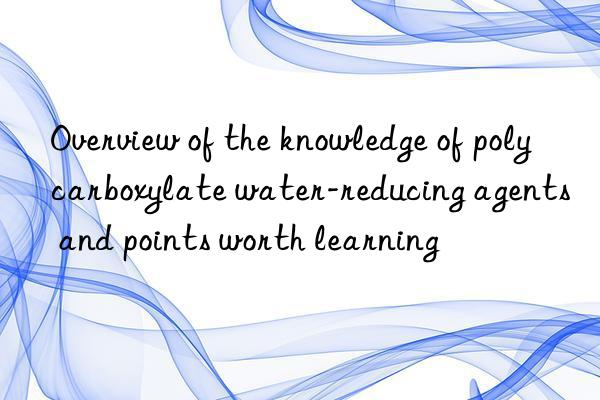
New varieties of concrete are constantly increasing, and the application of high-efficiency water-reducing admixtures has also promoted the improvement of concrete construction technology and the leap in concrete quality. In response to many friends’ doubts about polycarboxylate water-reducing agents, this article will explain in detail the knowledge of polycarboxylic acid water-reducing agents. Polycarboxylic acid water-reducing agents have unique properties and structures, and have strong dispersion ability and dispersion durability. The water-reducing rate of water-reducing agents is so high that it will become the dominant direction for the development of water-reducing agents in the future.
The optimal dosage of various water reducing agents is different. The naphthalene series water reducing agent is about 0.5%-1.5% of the cement quality, and the strength increase is 10%-25% at this time. When the dosage of concrete admixture is large or low (relative to the optimal dosage), completely different and unexpected effects will often occur. Such as the speed of "slump" loss, the size of bleeding, retarding and accelerating setting, etc. Different admixtures have different suitable dosage ranges. If they are less than or greater than this range, they will not be able to play their essential role. Excessive dosage will prolong the setting time, and the water reduction rate and strength will not increase significantly. Especially for wood calcium, excessive dosage will cause the concrete to not set for a long time. Excessive dosage of high-efficiency water-reducing agent will cause serious bleeding, poor workability, and technical and economic unreasonableness.
Six steps to introduce the performance of polycarboxylate water-reducing agent:
(1) High water-reducing rate: The dosage of this product is 0.15~0.3% (based on solid content) , the water reduction rate is 18-40%, which can meet the needs of ultra-low water-cement ratio and high-fluidity concrete, while saving 10-20% of cement.
(2) Excellent workability: The concrete prepared with this product has good workability, no segregation, no delamination, good cohesion, and is suitable for long-distance transportation and pumping.
(3) Green and environmentally friendly: This product adopts free radical aqueous solution polymerization. The raw materials do not contain formaldehyde and other pollutants. There is no sewage and wastewater discharge during the synthesis process. It has ultra-low environmental load and is a new type of green and environmentally friendly. type building materials.
(4) Low slump loss: This product introduces long side chains of macromolecules during the synthesis process, which on the one hand inhibits hydration and on the other hand provides steric hindrance, which can keep the slurry for a long time Maintain plasticity and have good slump retention.
(5) High durability: This product uses free radical aqueous solution polymerization, with very little chloride ion content. It only uses a small amount of alkali for neutralization. The alkali content is extremely low, and the alkali content and chloride ion content are relatively stable. , low chlorine and low alkali can greatly improve the durability of concrete.
(6) Low shrinkage and anti-cracking: This product can reduce the heat of hydration and delay the exothermic peak. It is suitable for large-volume concrete and can effectively reduce the cracking of concrete caused by the hydration temperature difference.
Different functional groups contained in concrete admixtures such as -OH, -SO3, -COOH, -CH2, etc. have different effects on cement particles. The molecular weight and shape of the admixture will affect the performance of the admixture. Is the concrete admixture an anionic surfactant or a cationic surfactant? C3A, CAF, C3S, etc. in cement have different adsorption and dispersion effects, which also directly affect the solubility of SQ42- in cement, thus leading to problems with the adaptability of concrete admixtures and cement. In the Tai'an area, most admixtures are the sodium salt of β-naphthalene sulfonic acid formaldehyde high condensate. During construction, when the admixtures are not compatible with the cement used and it is impossible to replace the cement, you can ask the admixture manufacturer to adjust the admixtures. The composition of the admixture should be adjusted to achieve good adaptability between the admixture and cement.
</p

 微信扫一扫打赏
微信扫一扫打赏

